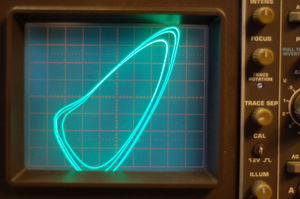Difference between revisions of "Template:NewsItem11x07x23x0"
m (moved NewsItem11x07x23x0 to Template:NewsItem11x07x23x0) |
|||
| Line 1: | Line 1: | ||
| − | [[File:4-period.JPG|thumb]] Of course, one could take a look at [https://revspace.nl/cam1/ our webcam] (but be quick, it might finally become password protected soon), but to appreciate the pure nature of chaos it is much more scientific to isolate it and show it's characteristics in a lab setting. Or a hackerspace. | + | [[File:4-period.JPG|thumb|left]] Of course, one could take a look at [https://revspace.nl/cam1/ our webcam] (but be quick, it might finally become password protected soon), but to appreciate the pure nature of chaos it is much more scientific to isolate it and show it's characteristics in a lab setting. Or a hackerspace. |
Hence the [[ChaoticCircuits|below experiment]], carried out by one of our most recent members and assistant professor at the TU Delft. He replicates a classic circuit that allows one to easily explore chaos, bifurcation and strange attractors from the comfort of one's electronics workbench. Driving the simple circuit, consisting of an inductor, a resistor and a diode, with a function generator drives the diode into a chaotic state. By varying amplitute and frequency of the sinusoid input various stable and unstable states can be visualised on an oscilloscope or even made audible. | Hence the [[ChaoticCircuits|below experiment]], carried out by one of our most recent members and assistant professor at the TU Delft. He replicates a classic circuit that allows one to easily explore chaos, bifurcation and strange attractors from the comfort of one's electronics workbench. Driving the simple circuit, consisting of an inductor, a resistor and a diode, with a function generator drives the diode into a chaotic state. By varying amplitute and frequency of the sinusoid input various stable and unstable states can be visualised on an oscilloscope or even made audible. | ||
Revision as of 03:21, 2 October 2011
Of course, one could take a look at our webcam (but be quick, it might finally become password protected soon), but to appreciate the pure nature of chaos it is much more scientific to isolate it and show it's characteristics in a lab setting. Or a hackerspace.
Hence the below experiment, carried out by one of our most recent members and assistant professor at the TU Delft. He replicates a classic circuit that allows one to easily explore chaos, bifurcation and strange attractors from the comfort of one's electronics workbench. Driving the simple circuit, consisting of an inductor, a resistor and a diode, with a function generator drives the diode into a chaotic state. By varying amplitute and frequency of the sinusoid input various stable and unstable states can be visualised on an oscilloscope or even made audible.
